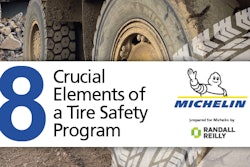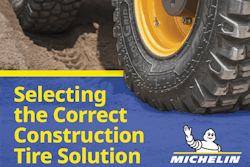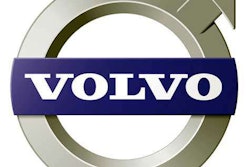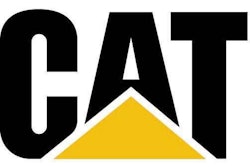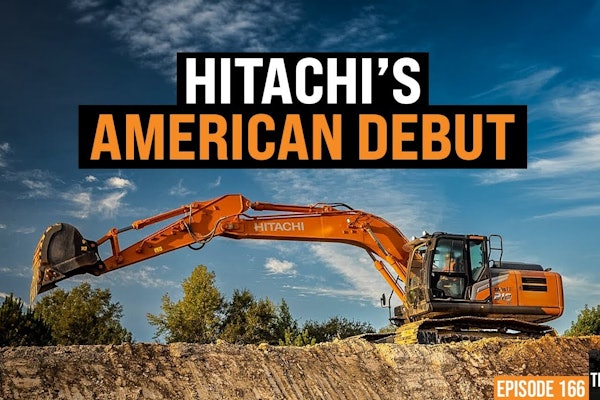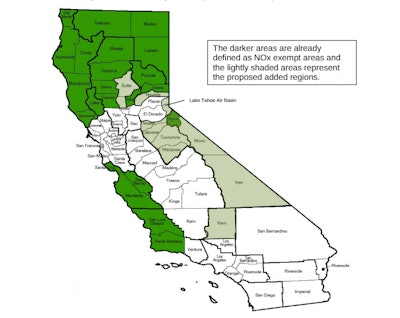 The areas highlighted in light green represent NOx exempt counties where trucks can now run compliantly until Jan. 1, 2015, with pre-2006 model engines.
The areas highlighted in light green represent NOx exempt counties where trucks can now run compliantly until Jan. 1, 2015, with pre-2006 model engines.The California Air Resources Board voted April 25 to amend some of its emissions regulations deadlines, giving new alternatives to owner-operators and small fleets who were unable financially to comply with the original rule. The amendments passed 11-1, though with some additional changes requested by the Board.
Final versions of the amendments will be produced within the next few months and will have a 15-day public comment period, after which CARB will put them into effect.
Changes to the regulations that will directly affect contractors are a redefinition of “low-mileage construction trucks” and extended compliance dates for those trucks. With the approved changes, low-mileage construction trucks are now referred to as “work trucks.”
These trucks travel less than 20,000 miles per year and owners were tasked with a compliance deadline schedule that required fleets with work trucks to have 33 percent of their fleet in compliance by January 1 2014, 66 percent by January 1 2015 and 100 percent by January 1, 2016. The new schedule has been extended over the next four years and the full-compliance date is now 2018.
The vote came a day after the Board heard more than five hours of impassioned testimony from fleet reps and owner-operators alike, with some speaking for the amendments and some speaking against. Click here to read sister site CCJ’s full coverage of the CARB hearings from April 24.
Other key changes implemented by the amendments include:
Loan denial extension
For owners of three or fewer trucks who were denied a loan, the Board voted to allow operation of those trucks as-is — without a filter — if the owners make a commitment to buy a new truck by December 2016 or have a particulate matter filter installed, also by December 2016.
This differs from the original proposal, which would have allowed them to run non-compliant until Jan. 1, 2018, if they committed to buying a new truck and did not include the PM filter commitment option.
The Board said it was swayed to shorten that time based on testimony and written comment from truck owners who did comply, saying they invested thousands if not millions of dollars in bringing their equipment to compliance.
Many stakeholders also voiced concerns about truck owners using the loan denial excuse as a means to avoid compliance, even if they hadn’t been denied. Board members agreed the amendment needs to include certain safeguards to prevent fraud: Truck owners will now be required produce supporting documents, use certain types of lenders and sign documents under penalty of perjury attesting to their loan denial.
NOx exempt counties extension, expansion
The amendments include a provision to delay the particulate matter filter retrofit deadline for trucks running only in NOx exempt counties to Jan. 1, 2015 — extending the previous Jan. 1, 2014, deadline. They also include an expansion of the NOx exempt areas, adding some counties to list (see the map above).
Expanded credits
The changes will push back three years, from 2020 to 2023, the date by which truck owners must replace an older truck with a 2010 or later year model truck and engine, if they installed a PM filter on a truck with an ’06 year model engine by the Jan. 1, 2014, deadline.
Extended phase-in deadlines for small fleets
Truck owners with three or fewer trucks now have an extra year to bring their second truck into compliance and an extra two years for their third truck, as the Board extended the phase-in deadlines for second and third trucks from Jan. 1, 2015, and Jan. 1, 2016, to Jan. 1, 2016, and Jan. 1, 2018, respectively.
With these deadline extensions, the Board said it could look into trying to secure more funds and distribute grant money to help owners comply — another change to the original proposed amendments.
Low-use exemption changes
The low-use exemption requirements now include trucks that travel fewer than 5,000 miles in a year total, in California or otherwise, in addition to those that run 1,000 miles or fewer in California.
Editor’s Note: James Jaillet is the news editor for sister sites Overdrive and CCJ.



